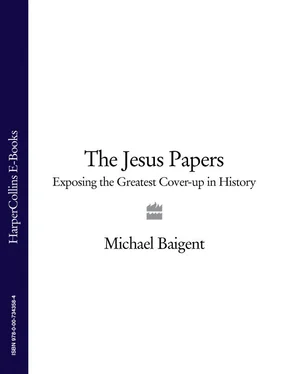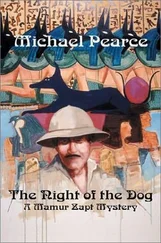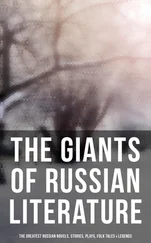The most believable documents, we thought, would be the most apparently mundane, those with no agenda to serve, no argument to support—an inventory perhaps, a historical equivalent of a shopping list. Something like a Roman legal document stating in a matter-of-fact manner: “Item: Alexandria, Fourth year of Claudius (A.D. 45), report of Jesus ben Joseph, an immigrant from Galilee, formerly tried and acquitted in Jerusalem by Pontius Pilate, today confirmed as the owner of a plot of land beyond the city walls.”
But it all seemed a bit far-fetched.
After Holy Blood, Holy Grail appeared and the dust had settled, out of personal curiosity more than anything else, we decided to visit the author of the letter and see what we could make of him. We needed to know whether he was believable or not. He lived in Leafield, Oxfordshire, a rural county of England comprising idyllic villages with stone houses centered upon the ancient university town of Oxford. The Rev. Bartlett lived in one of the small villages set in the higher country to the northwest of the county. We talked to him one afternoon in his garden, sitting on a wooden bench. It was the normality of the setting that made the topic of our conversation all the more remarkable.
“In the 1930s, I was living in Oxford,” reported the Rev. Bartlett. “In the same street was a ‘high-powered’ figure in the Church of England, Canon Alfred Lilley. I saw him every day.” Canon Alfred Leslie Lilley (1860-1948) had been, until his retirement in 1936, Canon and Chancellor of Hereford Cathedral. He was an expert in medieval French and for that reason was often consulted on difficult translation work.
During their daily talks, Lilley and Bartlett became closer, and Lilley eventually trusted Bartlett sufficiently to tell him an extraordinary story. In the early 1890s, Lilley reported, he had been asked by a young man, a former student of his, to travel to Paris to the Seminary of Saint Sulpice to advise on the translation of a strange document (or perhaps documents—Bartlett could no longer remember exactly) that had appeared from a source that was never divulged. At Saint Sulpice there was a group of scholars whose task it was to comb through all the documents that came in—a task performed, Lilley suspected, at the request of a Vatican cardinal. The scholars asked for help on the translation because they couldn’t really make out the text. Perhaps it seemed so outrageous to them that they thought they were misunderstanding it in some manner.
“They didn’t know that it was so close to the bone,” Bartlett recalled Lilley explaining. “Lilley said that they wouldn’t have a long and happy life if certain people knew about it. It was a very delicate matter. Lilley laughed over what was going to happen when the French priests told anyone about it. He didn’t know what happened to them [the documents], but he thought that they had changed hands for a large sum of money and had ended up in Rome.” In fact, Lilley thought that the Church would ultimately destroy these documents.
Lilley was quite certain that these documents were authentic. They were extraordinary and upset many of our ideas about the Church. Contact with the material, he said, led to an unorthodoxy. Lilley did not know for certain where the documents had come from but believed that they had once been in the possession of the heretical Cathars in the south of France during the twelfth and thirteenth centuries, even though they were much older. He was also sure that following the demise of the Cathars the documents had been held in Switzerland until the wars of the fourteenth century, when they were taken to France.
“By the end of his life,” Bartlett explained, “Lilley had come to the conclusion that there was nothing in the Gospels that one could be certain about. He had lost all conviction of truth.”
Henry and I were stunned. Bartlett was no fool. Not only was he a church minister with a master’s degree from one of the Oxford colleges, but he also held a science degree in physics and chemistry from the University of Wales, as well as a medical degree, also from Oxford. He was a member of the Royal College of Surgeons and the Royal College of Physicians. To call him highly educated was something of an understatement. He clearly admired Canon Lilley and greatly respected his learning and had no doubt whatsoever that Lilley had been accurately describing the document, or documents, he had seen during that trip to Paris. We needed to study Lilley and see if we could glean any further information about the material concerning Jesus and determine who at the Seminary of Saint Sulpice and the Vatican might have had an interest in it.
The key to understanding Canon Lilley was that he considered himself a “Modernist”; he was the author of a book on the movement that was extremely influential at the beginning of the twentieth century. The Modernists wished to revise the dogmatic assertions of church teachings in the light of the discoveries made by science, archaeology, and critical scholarship. Many theologians were realizing that their confidence in the historical validity of New Testament stories was misplaced. For example, William Inge, Dean of St. Paul’s Cathedral, was once asked to write on the life of Jesus. He declined, saying that there was not nearly enough solid evidence to write anything at all about him.
During the nineteenth century the Vatican was becoming increasingly anachronistic. The Papal States stretching from Rome across to Ancona and up to Bologna and Ferrara still existed, and the pope ruled like a medieval potentate. Torture was regularly practiced by the anonymous minions of the Inquisition in their secret jails. Those convicted in papal courts were sent as oarsmen to the galleys or were exiled, imprisoned, or executed. A well-used gallows stood in the town square of every community. Spies lurked everywhere, and repression was the rule; modernity was being kept at arm’s length—even railways were banned by the pope for fear that travel and communication between people would harm religion. And all this was occurring against a backdrop of a Europe where pressure for social change in the form of liberation movements opposing despotic power and encouraging parliamentary rule had become the norm.
Despite willful ignorance, the outside world was spilling over the crumbling borders of the papal domains. Change was beginning to seem inevitable. Democratic political philosophy, a growing social awareness, and the mounting criticism of biblical texts and their inconsistencies were causing religious certainties to buckle under the strain. And to the horror of Catholic conservatives, papal political power too was under direct threat. This was a real problem: in 1859, following a war between Austria and France that saw the defeat of the Catholic Hapsburg forces, the great majority of the papal lands joined the newly created kingdom of Italy. The pope, Pius IX, summarily demoted by events, now ruled over only Rome and a fragment of the surrounding countryside. And it grew worse: on 21 September 1870, even this small patrimony was taken away by Italian troops. The pope found himself left with just the walled enclave of Vatican City, where his successors continue to rule today.
Just before the loss of Rome, the pope, in what seems to have been considerable desperation, had called a General Council of Bishops to shore up his power. Yet by calling this council, the pope was implicitly recognizing the limitations of that power. The question of who held the reins had long been a festering sore at the Vatican. The uncomfortable truth was that the pope derived his legitimacy, not from the apostle Saint Peter, two thousand years earlier as he claimed, but from a much more mundane and worldly source: a Council of Bishops that had met at Constance in the early fifteenth century. At that time there had been three popes—a trinity of pontiffs united only in mutual loathing—all claiming, simultaneously, to have supreme authority over the Church. This ludicrous situation had been resolved by the bishops, who claimed—and were recognized in this claim—to hold legitimate authority. From that point on, the popes held their authority by virtue of the bishops. Accordingly, every pope was bound, when wishing to make a major change, to seek their approval.
Читать дальше












